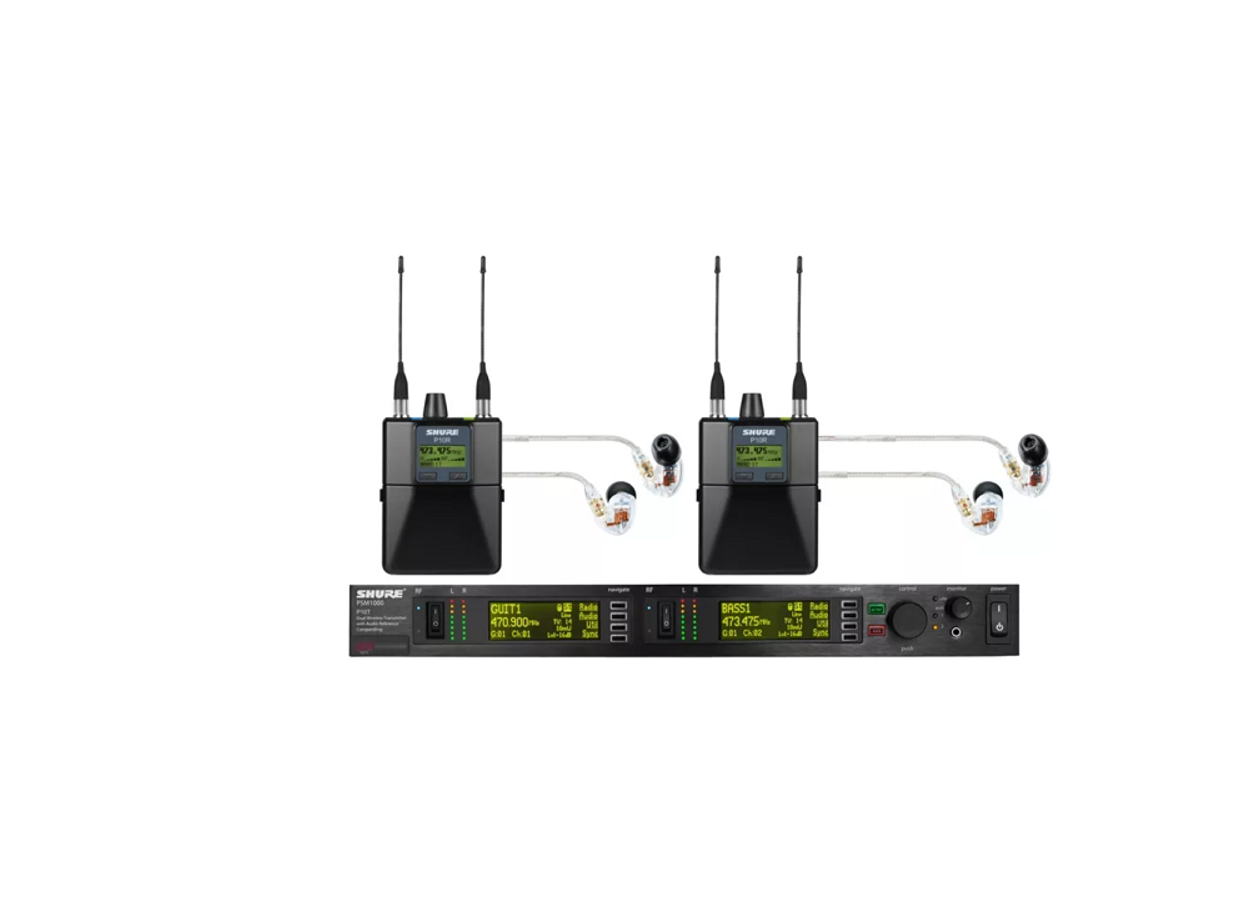SHURE PSM1000 Wireless Personal Monitor System User Guide
IMPORTANT SAFETY INSTRUCTIONS
- READ these instructions.
- KEEP these instructions.
- HEED all warnings.
- FOLLOW all instructions.
- DO NOT use this apparatus near water.
- CLEAN ONLY with dry cloth.
- DO NOT block any ventilation openings. Allow sufficient distances for adequate ventilation and install in accordance with the manufacturer’s instructions.
- DO NOT install near any heat sources such as open flames, radiators, heat registers, stoves, or other apparatus (including amplifiers) that produce heat. Do not place any open flame sources on the product.
- DO NOT defeat the safety purpose of the polarized or grounding type plug. A polarized plug has two blades with one wider than the other. A grounding type plug has two blades and a third grounding prong. The wider blade or the third prong are provided for your safety. If the provided plug does not fit into your outlet, consult an electrician for replacement of the obsolete outlet.
- PROTECT the power cord from being walked on or pinched, particularly at plugs, convenience receptacles, and the point where they exit from the apparatus.
- ONLY USE attachments/accessories specified by the manufacturer.
- USE only with a cart, stand, tripod, bracket, or table specified by the manufacturer, or sold with the apparatus. When a cart is used, use caution when moving the cart/apparatus combination to avoid injury from tip-over.

- UNPLUG this apparatus during lightning storms or when unused for long periods of time.
- REFER all servicing to qualified service personnel. Servicing is required when the apparatus has been damaged in any way, such as power supply cord or plug is damaged, liquid has been spilled or objects have fallen into the apparatus, the apparatus has been exposed to rain or moisture, does not operate normally, or has been dropped.
- DO NOT expose the apparatus to dripping and splashing. DO NOT put objects filled with liquids, such as vases, on the apparatus.
- The MAINS plug or an appliance coupler shall remain readily operable. The airborne noise of the Apparatus does not exceed 70dB (A).
- Apparatus with CLASS I construction shall be connected to a MAINS socket outlet with a protective earthing connection.
- To reduce the risk of fire or electric shock, do not expose this apparatus to rain or moisture.
- Do not attempt to modify this product. Doing so could result in personal injury and/or product failure.
- Operate this product within its specified operating temperature range.
SAFETY PRECAUTIONS
The possible results of incorrect use are marked by one of the two symbols—”WARNING” and “CAUTION”—depending on the imminence of the danger and the severity of the damage.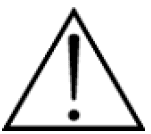 WARNING: Ignoring these warnings may cause severe injury or death as a result of incorrect operation.
WARNING: Ignoring these warnings may cause severe injury or death as a result of incorrect operation.


CAUTION
- Never disassemble or modify the device, as failures may result.
- Do not subject to extreme force and do not pull on the cable or failures may result.
- Keep the product dry and avoid exposure to extreme temperatures and humidity.
WARNING
- If water or other foreign objects enter the inside of the device, fire or electric shock may result.
- Do not attempt to modify this product. Doing so could result in personal injury and/or product failure.
WARNING: Battery packs shall not be exposed to excessive heat such as sunshine, fire, or the like. This device is able to produce sound volume higher than 85 dB SPL. Please check your maximum allowed continuous noise exposure level based on your national employment protection requirements
WARNING
LISTENING TO AUDIO AT EXCESSIVE VOLUMES CAN CAUSE PERMANENT HEARING DAMAGE. USE AS LOW A VOLUME AS POSSIBLE.
Over exposure to excessive sound levels can damage your ears resulting in permanent noise-induced hearing loss (NIHL). Please use the following guidelines established by the Occupational Safety Health Administration (OSHA) on maximum time exposure to sound pressure levels before hearing damage occurs.
| 90 dB SPLat 8 hours | 95 dB SPLat 4 hours | 100 dB SPLat 2 hours | 105 dB SPLat 1 hour |
| 110 dB SPLat ½ hour | 115 dB SPLat 15 minutes | 120 dB SPLAvoid or damage may occur |
This product is intended for professional use only. This product should only be sold through professional sales channels.
HEARING PRECAUTIONS
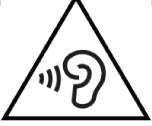

Important Product Information
LICENSING INFORMATION
Licensing: A ministerial license to operate this equipment may be required in certain areas. Consult your national authority for possible requirements. Changes or modifications not expressly approved by Shure Incorporated could void your authority to operate the equipment. Licensing of Shure wireless microphone equipment is the user’s responsibility, and licensability de pends on the user’s classification and application, and on the selected frequency. Shure strongly urges the user to contact the appropriate telecommunications authority concerning proper licensing, and before choosing and ordering frequencies.
Information to the user
This device complies with part 15 of the FCC Rules. Operation is subject to the following two conditions:
- This device may not cause harmful
- This device must accept any interference received, including interference that may cause undesired
Note: This equipment has been tested and found to comply with the limits for a Class B digital device, pursuant to part 15 of the FCC Rules. These limits are designed to provide reasonable protection against harmful interference in a residential installa tion. This equipment generates uses and can radiate radio frequency energy and, if not installed and used in accordance with the instructions, may cause harmful interference to radio communications. However, there is no guarantee that interference will not occur in a particular installation. If this equipment does cause harmful interference to radio or television reception, which can be determined by turning the equipment off and on, the user is encouraged to try to correct the interference by one or more of the following measures:
- Reorient or relocate the receiving
- Increase the separation between the equipment and the
- Connect the equipment to an outlet on a circuit different from that to which the receiver is
- Consult the dealer or an experienced radio/TV technician for
This device contains license exempt transmitter(s)/receiver(s) that comply with Innovation, Science and Economic Develop ment Canada’s licenceexempt RSS(s). Operation is subject to the following two conditions:
- This device may not cause
- This device must accept any interference, including interference that may cause undesired operation of the device.
Industry Canada ICES-003 Compliance Label: CAN ICES-3 (B)/NMB-3(B)Note: EMC conformance testing is based on the use of supplied and recommended cable types. The use of other cable types may degrade EMC performance. Changes or modifications not expressly approved by the manufacturer could void the user’s authority to operate the equipment.
PSM 1000
The PSM 1000 Personal Monitor System from Shure brings personal monitoring to its most advanced level yet. The full-rack, dual-channel, networkable transmitter is ideally suited for the demands of professional touring and installation applications, and the diversity bodypack receivers deliver pristine RF signal and audio quality. Networkability over Ethernet connection enables remote control of transmitter functions and comprehensive frequency coordination via Wireless Workbench software.
Components
- P10T Rackmount Transmitter
- P10R+ Bodypack Receiver (2)
- Two 1/2 Wave Antennas
- AA Batteries (4)
- Antenna Cables (2)
- IEC Power Cable and IEC Extension Cable
- Ethernet Network Cable
- Zippered Bag
Rackmount supplies:
- 2 antenna hole plugs
- 4 rack mounting screws with washers


Quick start Instructions
Rack Mount Transmitter
- Connect to a power outlet using the supplied power cable.
- Attach the supplied antennas to the antenna out BNC connectors.
- Connect the audio source, such as the output of a mixer, to the audio inputs. You can use both input jacks or choose either one for a mono source.
- Switch RF off and power on.
- For mono (one input), access the Audio menu and select Mono.
- Adjust the audio source level so that, for the average input signal level, the top two yellow LEDs flicker and the lower LEDs are solid. If the red clip LED illuminates and a warning appears on the LCD, the inputs are overdriven. Decrease the audio input level to +4 dBu from the Audio menu. If the signal level is too low, change the input sensitivity to –10 dBV
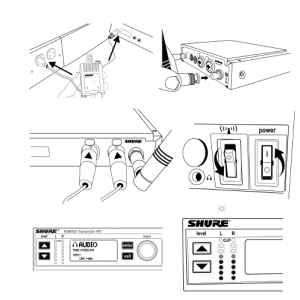

Bodypack
Open by pressing the latches on both sides and pulling. Insert the batteries or battery pack and attach antennas. Turn on using the volume knob. The battery light illuminates.
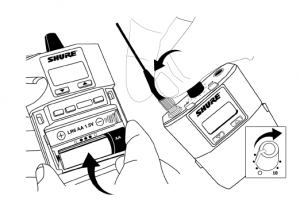

Scan and Sync
- On the bodypack, press the scan button. The display flashes SYNC NOW….
- Align the IR windows on the bodypack and rack unit, the IR window on the transmitter illuminates. Press the sync button on the transmitter. The rack unit Level LEDs flash, and the screen displays SYNC SUCCESS.
- Turn the RF switch on. The blue RF LED illuminates on the bodypack to indicate that it is detecting the transmitter. The bodypack also displays the RF signal strength (RF).
- Important: Turn bodypack volume down before plugging in earphones.
- Insert the earphones and slowly turn up the volume
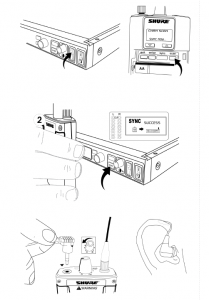

Front Panel Controls


- Sync WindowAlign bodypack IR window with sync window on TX.
- RF SwitchMutes RF output. For setting up multiple systems or adjusting settings without transmitting unwanted RF or audio signals.
- Audio IndicatorsUse the control wheel to adjust the audio so that, for the average input signal level, the top two yellow LEDs flicker and the lower LEDs are solid. Press the enter button to save the value, exit to cancel. The red clip LED indicates the inputs are overdriven. Reduce the level at the audio source or change the input sensitivity of the rack unit from the Audio > Input menu.
- Status Display and ControlsUse the navigation buttons to access the configuration menu. Push the control wheel to move the cursor to the next item.Turn the control wheel to change a parameter—the enter button flashes. Press it to save the value. Press the exit button to cancel changes and return to the previous menu.
- Headphone MonitoringThe monitor control adjusts signal output to the 3.5 mm headphone jack. Push button to toggle between transmitters. Monitor clip LED indicates headphone audio is clipping.
- Power SwitchTurns the unit on and off.
Rear Panel


- Primary power switchThis switch disconnects power to the unit. It is not affected by the interface power lock in the Util menu. Only the front power switch can be locked.
- Power plugAC mains power input, IEC Connector 100-240 Vac.
- AC mains power passthroughUse with an IEC extension cable to supply AC power to another device. Unswitched.
- Antenna (BNC) portAttach supplied antennas. If you are rack mounting, use a front panel or remote mounting kit from Shure.
- loop outSends audio signal going into the transmitter to another device.
- Audio InputsConnect to balanced or unbalanced outputs. Use either jack for mono input. Accepts male XLR or 6.35 mm (1/4-inch) TRS plugs.
- Ethernet JackTwo-port RJ-45 Ethernet jack for connection to a network or computer
Bodypack Receiver
① Power Switch and Volume ControlTurns the bodypack on and off and adjusts earphone volume.② 3.5 mm Earphone JackInsert earphones here.③ Scan ButtonPress the scan button to find an available frequency. Press and hold for two seconds to find the group with the most availablechannels.④ IR WindowFor transmitting settings between bodypack and rack unit.⑤ Battery CompartmentRequires 2 AA batteries or Shure rechargeable battery. Open by pressing the latches on both sides and pulling.⑥ Menu buttonsUse in conjunction with the ▼▲ buttons to access the configuration menus.⑦ ▼▲ ButtonsUse to adjust the audio mix (in MixMode only), or in conjunction with the menu buttons to change settings.⑧ LCD ScreenDisplays current settings and menus.⑨ Tri-Color Battery LEDIlluminates green, amber, or red to indicate battery power. When red, change battery immediately.⑩ Blue RF LEDIndicates the bodypack is receiving a signal from the transmitter.⑪ SMA ConnectorFor detachable antennas.⑫ Removable AA AdapterRemove to use with a Shure SB900B rechargeable battery.
Note: To remove adapter, open door and slide out. To reinstall adapter, place over the clip and press, there will be an audible click when seated.
RF SettingsAccess the following RF settings from the RADIO menu.GGroup number. Each group contains channels selected to work well together in a single installation.CHChannel number. Sets the receiver to a channel in the selected group.888.888 MHzDisplays the frequency to which the transmitter is set. Highlight and use the ▼▲ buttons to set the transmitter to a specificfrequency.SQUELCHAdjusts the squelch setting.FULL SCANPerforms spectrum scan and displays open frequencies in a graphical interface.RF PADAttenuates antenna signals in 3 dB increments.ANTENNASelection for single antenna operation. Disables diversity reception.Audio SettingsAccess the following audio settings from the Audio menu.
Output Mode (MODE)STEREOReceive left and right inputs as a stereo signalMIXMODE®Set your receiver to combine the left and right channel for simultaneous listening in both ears or pan to listen to only the left or right channel Four-Band Parametric Equalizer (EQ) The parametric equalizer is divided into four frequency bands: LOW, LOW MID, HIGH MID, and HIGH. When the EQ is enabled, the following parameters are adjustable:FREQUENCYSelect the center frequency of the band to boost/cutQAdjusts the width and slope of the frequency band (measured in octaves)GAINAdjustable in 2 dB increments from -6 dB (cut) to +6 dB (boost)
NOTE: HIGH and LOW are shelf filters, and therefore do not have adjustable Q widths. The HIGH shelf is fixed at 10 kHz; the LOW shelf is fixed at 100 Hz.


Volume Limiter (V LIM)V LIMSet a value (OFF to 48dB, adjustable in 3 dB increments) to attenuate the highest possible volume level. Turning the volume knob through its entire range of motion still affects volume; the limit simply narrows the range of dB adjustment.
Note: The volume limit does not compress the audio signal.
Volume Lock (V LOCK)P9RA+ and P10R+ onlyON
The volume is locked to the physical position of the volume knobInput EQ Preset (EQPre)Input EQ affects the signal after it is sent to the receiver, but before the headphone output, modifying the overall sound of theentire system.Match (default)Matches the frequency response of legacy PSM receivers, allowing for matched audio with mixed-inventory setupsFlatOffers a flat frequency response curveOffAudio bypasses input EQ
Balance (BAL ST / BAL MIX)▼▲ ButtonsLeft and right balance for earphones when in stereo mode, or mix of left and right channel for MixModeUtilities and Display SettingsAccess the following settings from the UTILITIES menu.CUEMODEEnters CUEMODE to exit, press enter and select EXIT CUEMODEDISPLAYChange the display settings on the bodypackCONTRASTSets display brightness to high, low, or medium.LOCK PANELLocks all controls except power and volume.To unlock, press exit, select OFF, and press enter.BATTERYWhen using a Shure rechargeable battery, the following information is displayed: Hrs: Min Left, temperature, Status, CycleCount, and Health.AUTO OFFSets the time at which the receiver is powered off after entering power-save mode (when POWER SAVE is displayed onthe screen).RESTOREReturns receiver to factory default settings.
Battery Life
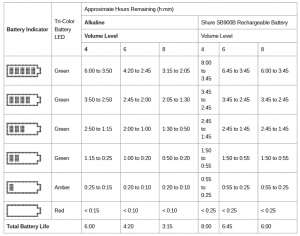

Power-save mode: When there are no earphones plugged in for 5 minutes, the receiver enters power-save mode to preserve battery life. The LED slowly fades on/off in this mode and continues to display the color that represents the remaining battery life.Note: Battery life using Energizer brand AA Alkaline batteries and the following conditions:
- Receiver audio set to V LIMIT = 0dB
- Transmitter audio INPUT set to Line+4 dBu and Level set to −9 dB
- Audio input to the transmitter: pink noise at +8.7 dBV
- Audio output at receiver: 115 dB SPL in ear with SE425 earphones (impedance at 22 Ώ) set at volume level
Note: Using lower-impedance earphones or ones with different sensitivity, different battery types, and higher gain settings in the PSM system may cause the receiver battery life to be different than specified.Pink noise is a signal with a frequency spectrum such that the power spectral density is inversely proportional to the frequency. In pink noise, each octave carries an equal amount of noise power.
Note: A Battery Hot warning indicates that transmitter battery needs to cool off. Otherwise, the transmitter will shut down. Let the device cool down and then consider swapping the transmitter battery to continue operation. Identify any possible external heat sources to the transmitter and operate the transmitter away from those external heat sources.All batteries should be stored and operated away from external heat sources in reasonable temperature conditions for best performance.
Multiple System Setup
When setting up multiple systems, designate a single bodypack to scan for available frequencies and download them to all the rack units.The bodypack must be from the same frequency band as all the transmitters.
- Power on all the rack Turn off the RF. (This prevents them from interfering with the frequency scan.)Note: Turn on all other wireless or digital devices as they would be during the performance or presentation (so the scan will detect and avoid any interferance they generate).
- Use the bodypack to scan for a group by pressing and holding the scan button for two seconds. The bodypack displays the group and the number of available channels, and flashes SYNC NOW….Important: Note the number of available channels. If you have more rack units than available channels, eliminate potential sources of interference and try again, or call Shure Applications for assistance.
- Sync the bodypack with the first rack unit by aligning the IR windows and pressing
- Press scan again on the bodypack to find the next available
- Sync the bodypack with the next rack
- Repeat with all the rack
- Sync each performer’s bodypack to its respective rack unit by aligning the IR windows and pressing snyc. DO NOT press scan on the
Turn on the RF on all rack units. The systems are ready to useAll batteries should be stored and operated away from external heat sources in reasonable temperature conditions for best performance.
CueMode
CueMode allows you to upload the name and frequency settings from multiple rack units and store them as a list on a single bodypack. You can then, at any time, scroll through that list to hear the audio mix from each transmitter, just as each performer does during a show.CueMode lists are retained even if CueMode is exited, the bodypack is turned off, or batteries are removed.Note: Set the channel frequency and assign display names for each transmitter before creating your CueMode list.
Adding Transmitters to the CueMode List
Note: The transmitter must be from the same frequency band as the bodypack.
- Open the battery door and press the enter
- From the main menu, scroll to UTILITIES and press Select CueMode and press enter again.
- Align IR windows and press sync on the rackThe LCD displays SYNC SUCCESS after frequency and name data are uploaded to the CueMode list. It also displays the CueMode number for that transmitter and the total number of transmitters.
- Repeat the above step for eachNote: Syncing while in CueMode does not change any of the settings on the bodypack.
Auditioning Mixes
- Enter CueMode from the UTILITIES
- Use the ▼▲ buttons to scroll through your CueMode list to hear the
Exiting CueMode
Exit CueMode by pressing enter and selecting EXIT CUEMODE.
Managing CueMode Mixes
REPLACE MIX
Select and press sync on a rack unit to upload new data for the current mix (for example, if you have changed the trans mitter frequency).
DELETE MIX
Removes the selected mix.
DELETE ALL
Removes all mixes.
EXIT CUEMODE
Exits CueMode and returns the bodypack to the previous frequency setting.
Frequency Scan
Use a frequency scan to analyze the RF environment for interference and identify available frequencies. There are three types of scan:
- Channel Scan Press the scan button on the Finds the first available channel.
- Group Scan Press and hold the scan button for two Finds the group with the greatest number of available chan nels. (Each group contains a set of frequencies that are compatible when operating multiple systems in the same environ ment.)
- Full Scan From the bodypack menu select RADIO > FULL SCAN. Press RUN SCAN to initiate a full Press SPECTRUM to view full results in a graphical display.Note: When performing a frequency scan:
- Turn off the RF on the transmitters for the systems you are setting (This prevents them from interfering with the fre quency scan.)
- Turn on potential sources of interference such as other wireless systems or devices, computers, CD players, large LED panels, effects processors, and digital rack equipment so they are operating as they would be during the presentation or performance (so the scan will detect and avoid any interference they generate).
Sync
You can transfer frequency settings in either direction: from the bodypack to the rack unit, or from the rack unit to the body pack.Note: You can also choose to transfer other settings to the bodypack during a sync, such as lock or mode settings, using the Sync > RxSetup menu on the rack transmitter
Downloading settings from the bodypack
- Press the scanbutton on the
- Align the IR windows and press the syncbutton from the rack transmitter LCD menu while the bodypack display is flashing “SYNC NOW…”.
The level LEDs on the rack unit flash.
Sending settings to the bodypack
- Press the Sync button on the rack transmitter to access the sync
- Align the IRWhen properly aligned the IR window on the transmitter illuminates.
- Press Sync to transfer settings.
The blue LED on the bodypack flashes.
Creating Custom Groups
This feature allows you to create your own groups of frequencies. Menu: Radio > Custom
- Turn the Control wheel to select a custom group from the Group (U1, U2, etc.)
- Push the Control wheel to move to the Channel parameter and turn it to select a channel (01, 02, 03, )
- Push the Control wheel to move to the Freq parameter and select a frequency for that
- Push the Next menu key to select a frequency for the next channel in that
- Select Load to find all other devices of the same model and band on the Then press enter to deploy the custom group list to all these devices.This overwrites all existing custom groups.
- Clear deletes all custom groups for all devices on the
MixMode
Some performers need to hear more of their own voice or instrument, while others want to hear more of the band. With Mix Mode, the performer creates their own mix using the balance control (▼▲ buttons) on the bodypack.To use MixMode, send a solo mix of the performer to the L/CH1 input on the transmitter, and send a band mix to the R/CH2 in put.Set the performer’s bodypack for MixMode. The bodypack combines the two signals and sends them to both earphones, while the balance control on the bodypack adjusts the relative levels for each. For IFB applications, send two independent program feeds into the L/CH1 and R/CH2 input of the transmitter. With MixMode, the director or broadcast talent can listen to either feed using the balance control (▼▲ buttons) on the bodypack to pan to ei ther audio signal.
LOOP Applications
Use LOOP OUT L (left) and R (right) outputs to send a copy of the audio signal going into the transmitter to other devices. Following are a few of the many applications for these outputs.Note: The input level control and the input pad do not affect the LOOP OUT signals.
MixMode for Multiple Systems
Configure each system for MixMode. From the mixing console, send a mix of the whole band to input 2 of the first transmitter. Connect the LOOP OUT R output to the R/CH2 input of the next transmitter. Continue the chain with all the transmitters.Next, create solo mixes for each performer. Send each mix to input 1 of the transmitter for that performer.
Floor Monitors
Send the audio from the LOOP outputs to onstage loudspeakers. The bodypack and the onstage monitors receive the same audio signals.Note: The LOOP audio outputs will not drive passive loudpeakers, and must be sent to a power amplifier or an active loudspeaker.
Recording Devices
To record a performance, connect the LOOP outputs to the inputs of a recording device.
Squelch
Squelch mutes audio output from the bodypack when the RF signal become noisy. While squelch is activated, the blue LED on the bodypack turns off.For most installations, squelch does not need adjustment, and it keeps the performer from hearing hiss or noise bursts if the RF signal becomes compromised. However, in congested RF environments or in close proximity to sources of RF interference (such as large LED video panels), the squelch may need to be lowered to prevent excessive audio dropouts. With lower squelch settings, the performer may hear more noise or hiss, but will experience fewer audio dropouts.Important: Before lowering squelch, first try to eliminate the problem by finding the best set of frequencies for your installation and removing potential sources of interference.
Caution: Turning off or lowering the squelch setting can increase the noise level and cause discomfort to the performer:
- Do not lower the squelch setting unless absolutely
- Turn earphone volume to the lowest setting before adjusting
- Do not change the squelch setting during a
- Turn up the transmitter level setting to make noise or hiss less
Squelch Settings
| HIGH (NORMAL) | Default factory setting. | |
| MID | Moderately decreases the signal-to-noise ratio required to squelch the receiver. | |
| LOW | Greatly decreases the noise squelch threshold. | |
| PILOT ONLY* | Turns off noise squelch leaving only pilot squelch on. | |
|
NO SQUELCH* |
Turns off noise and pilot tone squelch. (Sometimes used as a debugging tool by monitor engineers or RF coordinators to “listen” to the RF environment.) | |
| * Symbol appears in dis-
play window. |
Point-to-Point Wireless Audio
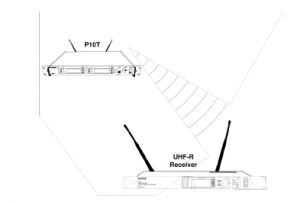

Use PTP mode to allow a P10T to transmit to a UHF-R receiver. This allows a transmitter and receiver setup where both units are racked and powered by AC.For more information visit: www.shure.com/americas/products/personal-monitor-systems
Ethernet Connection
Each transmitter has an RJ-45 port on the back for connecting to other transmitters over an Ethernet network. Networking transmitters allows you to automatically set frequencies for all the transmitters with a single group scan command.Add transmitters to a network using the default automatic network setting (Util > Network > Mode > Automatic):
- Connect transmitters to an Ethernet router with DHCP
- Use Ethernet switches to extend the network for larger
- Connect transmitters in
Accessing the Network with a Computer
You can control and monitor all networked transmitters through a computer running Shure Wireless Workbench software, Version 6 or later. If using the default automatic network setting, make sure your computer is configured for DHCP.Note: Some security software or firewall settings on your computer can prevent you from connecting to the transmitter. If using firewall software, allow connections on port 2201.
Static IP Addressing
Static IP addressing is also supported. An IP address can be assigned through the network menu (Util > Network > Mode > Manual).Note: Dual transmitters use a single IP address, which may be set through either LCD interface’
Connecting Transmitters


Spectrum Scan
Use this feature to scan the full RF spectrum for potential sources of interference and deploy open frequencies to all receivers on the network. A graphical representation of the scan data may be viewed on both the transmitter and receiver. This allows you to scroll through the graph to reveal details about the frequency and strength of the interfering signals.
Scanning and Deploying Frequencies
- Turn off RF on all
- Collect the scan data. From the bodypack receiver MAIN MENU, select RADIO > FULL SCAN > RUN SCANThe receiver displays SPECTRUM SCAN and scans the full spectrum.
- Load the scan data from the bodypack receiver to the rack Align the IR windows and press Sync > Spectrum > SyncScanThe receiver displays the scan data as a graph and gives options for viewing and deploying.
- Search network for devices. From the rack transmitter Sync > Spectrum menu, pressThe rack transmitter searches the network for all available transmitters.
- Choose a Use the control wheel to select from the available groups.The number of open frequencies for each group is displayed next to Open Frequencies.
- Deploy Press the flashing enter button to deploy frequencies to all channels.The LEDs flash on all affected channels.
Viewing Spectrum Data
From the Bodypack Receiver
MAIN MENU > RADIO > FULL SCAN > SPECTRUM
- Adjust the cursor position using the ▼▲
- Press enter to zoom in at the cursor Press exit to zoom out.
- Press scan to display frequency and power of signal at the cursor
From the Rack Transmitter
Sync > Spectrum
- Adjust the cursor position by pressing Cursor and using the control
- Frequency and power of signal at the cursor position is displayed at the top of the
- Press Zoom and use the control wheel to zoom in and out.
Updating Receiver Firmware
Use the following steps to update the firmware on a bodypack receiver.
- Use the WWB update manager to download the receiver firmware to the rack
- On the transmitter, navigate to the Util > More > FW Update
- Align the receiver and transmitter IR ports and press The download begins, which can take 50 seconds or longer.
Once the download is complete, the receiver automatically begins the firmware update, which overwrites the existing firmware.
CAUTION! Do not turn off the receiver until the update is complete.
Specifications
PSM 1000
RF Carrier Range
470–952 MHz
Compatible Frequencies
Per band39
Tuning Bandwidth
72–80 MHz
Operating Range
environment dependent
90 m ( 300 ft)
Audio Frequency Response
35 Hz–15 kHz (±1 dB)
Signal-To-Noise Ratio
A-Weighted
90 dB (typical)
Total Harmonic Distortion
ref. ±34 kHz deviation @1 kHz
<0.5% (typical)
Companding
Patented Shure Audio Reference Companding
Spurious Rejection
ref. 12dB SINAD
>80 dB (typical)
Frequency Stability
±2.5 ppm
MPX Pilot Tone
19 kHz (±0.3 kHz)
Modulation
FM*, MPX Stereo
Operating Temperature
-18°C to +57°C
P10T
RF Output Power
selectable: 10, 50, 100 mW (+20 dBm)
RF Output Impedance
50 Ω (typical)
Net Weight
4.7 kg (10.4) lbs
Dimensions
44 x 483 x 343 mm (1.7 x 19.0 x 13.5 in.), H x W x D
Power Requirement
| Input | 100–240 V AC, 50/60 Hz, 0.5 A max.
(5.5, with outlet loaded) |
| Output | 100–240 V AC, 50/60 Hz, 5 A max.,
unswitched |
Audio Input
Connector Type
Combination XLR and 6.35 mm (1/4″) TRS
Polarity
|
XLR |
Noninverting (pin 2 positive with re
spect to pin 3) |
| 6.35 mm (1/4″) TRS | Tip positive with respect to ring |
Configuration
Electronically balanced
Impedance
70.2 kΩ (actual)
Nominal Input Level
switchable: +4 dBu, –10 dBV
Maximum Input Level
| +4 dBu | +29.2 dBu |
| -10 dBV | +12.2 dBu |
Pin Assignments
| XLR | 1=ground, 2=hot, 3=cold |
| 6.35 mm (1/4″) TRS | Tip=hot, Ring=cold, Sleeve=ground |
Phantom Power Protection
Up to 60 V DC
Audio Output
Connector Type
6.35 mm (1/4″) TRS
Configuration
Electronically balanced
Impedance
Connected directly to inputs
P10R+
Tri-Band RF Filtering
–3 dB at 30.5 MHz from the center frequency of each band
Active RF Gain Control
31 dB
Active RF Sensitivity
at 20 dB SINAD2.2 µV
Image Rejection
>90 dB
Adjacent Channel Rejection
>70 dB
Latency
0.37ms
Squelch Threshold
22 dB
SINAD (±3 dB)
Intermodulation Attenuation
>70 dB
Blocking
>80 dB
Audio Output Power
1 kHz at Less than 1%distortion, Maximum Headphone Output Power, at 16 Ω
100 mW (per output)
Minimum Load Impedance
4 Ω
Output Impedance
4-band Parametric EQ
| Low Shelf | SelectableGain: ±2 dB, ±4 dB, ±6 dB @ 100 Hz |
|
Low Mid |
SelectableGain: ±2 dB, ±4 dB, ±6 dB at 160 Hz, 250 Hz,
400 Hz, 500 Hz, 630 HzSelectableQ: 0.7, 1.4, 2.9, 5.0, 11.5 |
|
High Mid |
SelectableGain: ±2 dB, ±4 dB, ±6 dB at 1 kHz, 1.6 kHz,
2.5 kHz, 4 kHz, 6.3 kHzSelectableQ: 0.7, 1.4, 2.9, 5.0, 11.5 |
| High Shelf | SelectableGain: ±2 dB, ±4 dB, ±6 dB @ 10 kHz |
Volume Limiter
Selectable: OFF (0 dB) to -48 dBin 3 dB steps
Volume Lock
Selectable: 0 dB to -70 dB
Net Weight
158 g (Without Battery)
Dimensions
99 x 66 x 23 mm (3.9 in. x 2.6 in. x 0.9 in.) H x W x D
Battery Life
4–6 hours (continuous use) AA batteries
Furnished Accessories
| Omnidirectional Whip Antenna, Yellow Tip (470-542 MHz) | UA700 |
| Omnidirectional Whip Antenna, Gray Tip (540-626 MHz) | UA710 |
| Omnidirectional Whip Antenna, Black Tip (596-692 MHz) | UA720 |
| Omnidirectional Whip Antenna, Blue Tip (670-830 MHz) | UA730 |
| Omnidirectional Whip Antenna, Red Tip (830-952 MHz) | UA740 |
| 1/2 Wave Omnidirectional Receiver Antenna for improved wireless signal reception | UA8 |
| Antenna extension cables (2) | 95B9023 |
| Carrying/Storage Bag | 95A2313 |
| Hardware Kit (Rack mounting Screws) | 90XN1371 |
| Bumper Kit | 90B8977 |
| AA battery adapter | 65A15224 |
Optional Accessories
| Passive Directional Antenna 470-952 MHz. Includes 10 foot BNC to BNC cable. | PA805SWB |
| PWS Helical Antenna, 480-900 MHz | HA-8089 |
| PWS Domed Helical Antenna, 480-900 MHz | HA-8091 |
| Wideband Omnidirectional Antenna (470-1100 MHz) | UA860SWB |
| 2 ft. BNC-BNC Coaxial Cable | UA802 |
| 6 foot (1.8m) BNC to BNC Coaxial Cable for Remote Antenna Mounting for ULX Wireless System |
UA806 |
| 25 ft. BNC-BNC Coaxial Cable | UA825 |
| 50 ft. BNC-BNC Coaxial Cable | UA850 |
| 100 ft. BNC-BNC Coaxial Cable | UA8100 |
| 4-to-1 antenna comber with power distribution to 4 transmitters (better RF perfor-
mance and eliminates need for external power supply) |
PA421B |
| 8-to-1 antenna combiner for better RF performance | PA821B |
| Coiled IFB Earphone Cable for Shure Earphones | EAC-IFB |
Frequency Range and Transmitter Output Power
| Band | Range | Output Power (mW) |
| G10 | 470–542 MHz | 10/50/100 mW |
| G10E | 470–542 MHz | 10/50 mW |
| G10J | 470–542 MHz | 6/10 mW |
| G11 | 479–542 MHz | 10 mW |
| G62 | 510–530 MHz | 10/50 mW |
| H8Z | 518–582 MHz | 10/50 mW |
| H22 | 518–584 MHz | 10**/50/100 mW |
| J8 | 554–626 MHz | 10/50/100 mW |
|
J8A |
554–608 MHz | 10/50/100 mW |
| 614–616 MHz | 10* mW | |
| J8E | 554–626 MHz | 10/50 mW |
| J8J | 554–626 MHz | 6/10 mW |
| K10E | 596–668 MHz | 10 mW |
| L8 | 626–698 MHz | 10/50/100 mW |
|
L8A |
653–657 MHz | 10 mW |
| 657–663 MHz | 10* mW | |
| L8E | 626–698 MHz | 10/50 mW |
| L8J | 626–698 MHz | 6/10 mW |
| L9E | 670–742 MHz | 10/50 mW |
| L11J | 670–714 MHz | 6/10 mW |
| M19 | 694–703 MHz | 10/50 mW |
| P8 | 710–790 MHz | 10/50/100 mW |
| Q12 | 748–758 MHz | 10/50 mW |
| Band | Range | Output Power (mW) |
| Q21 | 710–787 MHz | 10/50/100 mW |
| Q22E | 750–822 MHz | 10/50/100 mW |
| R27 | 794–806 MHz | 10/50 mW |
| X1 | 944–952 MHz | 10/50/100 mW |
| X7 | 925–937.5 MHz | 10 mW |
| X55 | 941–960 MHz | 10/50/100 mW |
NOTE: This Radio equipment is intended for use in musical professional entertainment and similar applications. This Radio apparatus may be capable of oper- ating on some frequencies not authorized in your region. Please contact your national authority to obtain information on authorized frequencies and RF power levels for wireless microphone products.
WARNING: As of January 01, 2019 the use of radio transmitters in the bands 694 – 823 MHz is prohibited.
P10T
Certified under FCC Part 74.*Certified under FCC Part 15.**Certified under FCC Part 15 and Part 74.Certified by ISED in Canada under RSS-123 and RSS-102.Meets essential requirements of the following European Directives:
- WEEE Directive 2012/19/EU, as amended by 2008/34/EC
- RoHS Directive EU 2015/863
Note: Please follow your regional recycling scheme for batteries and electronic waste
This product meets the Essential Requirements of all relevant European directives and is eligible for CE marking.
Australia Warning for Wireless
This device operates under an ACMA class licence and must comply with all the conditions of that licence including operating frequencies. Before 31 December 2014, this device will comply if it is operated in the 520-820 MHz frequency band.
WARNING: After 31 December 2014, in order to comply, this device must not be operated in the 694-820 MHz band.
Switzerland Warning for Wireless
WARNING: As of January 01, 2019 the use of radio transmitters in the bands 694 – 823 MHz is prohibited.Hereby, Shure Incorporated declares that the radio equipment is in compliance with Directive 2014/53/EU. The full text of the EU declaration of conformity is available at the following internet address: http://www.shure.com/europe/compliance Authorized European representative: Shure Europe GmbHHeadquarters Europe, Middle East & Africa Department: EMEA ApprovalJakob-Dieffenbacher-Str. 1275031 Eppingen, GermanyPhone: +49-7262-92 49 0Fax: +49-7262-92 49 11 4Email: [email protected]
Read More About This Manual & Download PDF:
References
[xyz-ips snippet=”download-snippet”]

